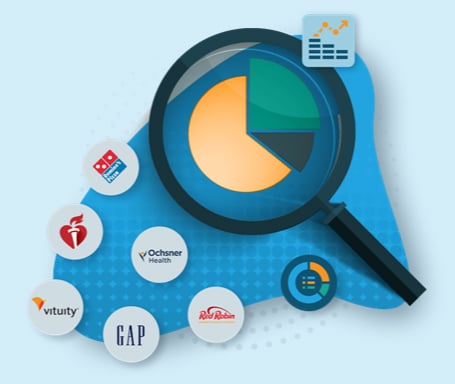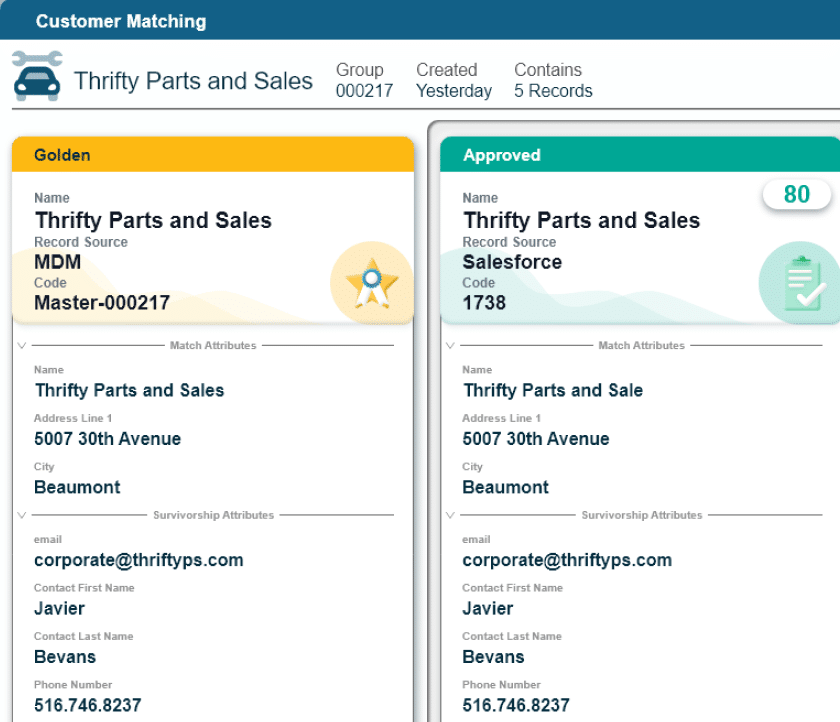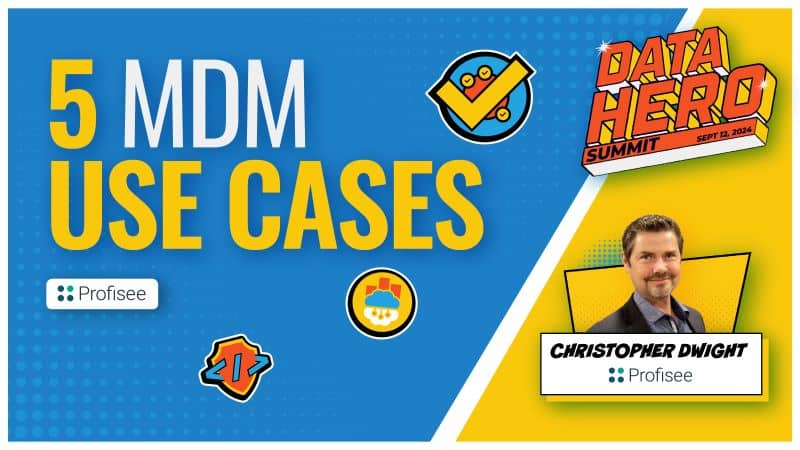According to Gartner, the No. 1 reason that master data management (MDM) implementations fail is a lack of a business case to qualify and quantify the business value that it brings to an organization.
In this comprehensive guide, we cover the six core components of successfully building an MDM business case, articulating it to leadership, securing funding and ultimately deploying MDM with long-term success.
This guide also features practical steps and an interactive discussion with Bill O’Kane, Profisee VP and MDM Strategist, and Christopher Dwight, Profisee VP of Customer Success. Listen to the audio clips throughout to learn first-hand how they advise leaders just like you on their MDM strategy.
Download your exclusive copy of the guide to keep in your back pocket. Or if you’re ready to dive in, continue your journey below.
Selling Master Data Management (MDM) to Leadership [6 Strategy Tips]

59:45

59:01

59:55

58:28

58:31

59:46
1. Organizational Readiness
Prefer to listen? Hear the full conversation with Bill and Christopher on organizational readiness below.
What does ‘ready’ look like?
When it comes to organizational readiness, you must first define what “ready” looks like.
Many organizations first look to master data management when their data quality problems begin getting in the way of strategic initiatives. But while every organization will experience data quality issues to some degree, simply having these issues does not necessarily mean you are prepared for an MDM implementation.
Common data quality issues can include:
- Data contains duplicates within the same database and across several internal and external sources
- Data is siloed across multiple source systems
- A lack of data governance protocols assigning data ownership and how records are managed, updated and stored.
While that may all be true — and while you think you might actually be ready because you are ready to do a data quality project or you are trying to start a Customer 360 project —— that alone doesn’t mean you are ready to implement a successful MDM project. Implementing MDM requires enterprise-wide commitment and alignment, and there are several factors to consider before embarking on an MDM journey.
Why do you think it’s important?
A key component to any MDM implementation is tying your technical requirements to a real business outcome. For example, the technical requirements for a ‘Customer 360’ engagement may include successfully stitching together all online and offline customer interactions into a single master record, the business outcome is for the organization to reduce shipping costs by 30%.
You can achieve that goal by de-duplicating data, enriching bad shipping addresses and decreasing the total of returned mailing catalogs. Bill and Christopher both make the case for focusing on the operational impact. That is the first big step when preparing for an MDM deployment.
Get business sponsorship
High-level business sponsorship is critical to getting an MDM project off the ground. But rather than telling your business stakeholders how you will solve their problems or which MDM strategy is the best fit, you again need to focus on a business case.
Starting with technical details or IT-centric KPIs is not only a poor strategic choice, but it can also doom an MDM implementation from the start by framing your MDM initiatives in terms that don’t resonate with your business stakeholders.
As “unclean” as your data might be, that is not on the business’ radar. Frankly, they don’t care about cleaning the data.
The business cares that they are sending duplicate catalogs and increased shipping costs. Money talks — and MDM must deliver a financial benefit first when seeking business backing for the initiative.
When pitching an MDM strategy, it is critical to address the specific pain point and articulate the solution. This will provide you with the sponsorship required to move forward.
It becomes a win-win scenario solving the business’ primary struggle while thoroughly cleaning and enhancing your data in the process.
Do you have a business case?
Like all enterprise initiatives, it is crucial to make a case when pitching an idea — more specifically, a business case. Once you pinpoint the source and define the business problem, it comes down to dollars and cents.
Frame your problem in business — or, ideally, financial — terms so stakeholders can understand the scale of the issue. For example, —is this a $3 million issue or a $30 million issue?
Knowing the root cause and what this issue can cost you overall if unaddressed is critical when prioritizing and initiating your strategic MDM initiative.
Key Takeaway: It’s important to understand the problems your business faces and build a vision of what solving that problem looks like to garner sponsorship. Create your roadmap to success that comes from solving the current problem at hand.
2. Understanding Your Why
Is your business properly positioned for a successful MDM implementation today?
To justify moving forward with your MDM project, it is crucial to focus your approach on the “why” and “how” of the project. Sure, it is easy to get stuck in the “what?” but asking yourself “why” allows you to gauge and define the scope of your efforts.
Scope management can go a long way when launching your next strategic initiative. For example, when focusing your project around:
- Increasing market share
- Reducing the sales cycle
- Improving the ability to cross-sell/up-sell
- Improving vendor terms
- Refining the low inventory model
Then you can dig into the specifics and plan a strong business case around the “why” of your MDM initiative.
But when you focus too much on the “what”, you reduce your chances of receiving funding.
Categorizing Business Benefits for Stakeholder Engagement
Below is a tool to help facilitate these further discussions by framing your MDM implementation in two key business benefits: revenue enhancement and cost efficiency. It also further categorizes current sub-optimal processes that need to be refined and net new processes that will bring greater efficiency to your organization.
Using this diagram helps simplify complex business problems and helps you collaborate with your business stakeholders on determining the best way to move your project forward.
As previously mentioned, businesses want results. They are looking for the project’s overall impact or outcome and how it can increase revenue opportunities as opposed to cleaning and enhancing the quality of your enterprise data. The potential of your outcome shows the value of your project while justifying its existence thus justifying the funding behind it.
It comes down to driving revenue sources and eliminating costly redundancies or setbacks. Creating an effective Business Impact Roadmap (BIR) allows you to see the full picture when prioritizing business outcomes to reinforce project value.
An effective, compelling business case is one that:
- Clearly describes the business opportunity
- Helps prioritize initiatives and resources
- Identifies key performance indicators
- Quantifies a projected return on investment
This creates a strong data foundation to drive other various projects ahead, paving the way for successful scope, prioritization selection, and — most importantly —stakeholder buy-in.
After applying these principles to your decision-making process and MDM project justification, you can determine if your organization is ready for a successful MDM implementation. Remember, preparation is key! Sit and ask yourself, “Are we ready?”
To determine where you are in the preparation process, it is important to determine whether key stakeholders across the entire organization are involved in your initiative.
Once you confirm that your stakeholders are on board with launching the project, you can then gather their input to determine whether your initiative is tied to a clear business outcome.
Finally, you can ensure your MDM initiative is effectively positioned to solve that pain point, that it is prioritized across the organization and that you have the ability to focus on the first quick win and build from there.
Key Takeaway: Think big but start small! Understand your project’s long-term benefits while also understanding how to solve a specific business problem. Do not give more than you receive. Ensure there is a comprehensive understanding of what the MDM project brings, the scale of the issue(s) being resolved and what it truly means to reach that resolution.
3. Total Cost of Ownership (TCO) Calculation
As stated before, MDM project success relies heavily on dollars and cents. As you prepare to launch, it is crucial to account for the investment portion and the components that go along with it. This is commonly referred to as total cost of ownership (TCO). If you want support for your project, then a breakdown of financial calculations and costs is needed. Below is a graphical example of how various components like software licensing, support/maintenance, hardware, hosting and other components factor into the total costs of licensing, or owning, enterprise software:There may be some additional costs that should play into your model. Here are some questions to consider:
- What does it look like/cost to upgrade new versions in future years?
- What are the costs associated with moving from on-premise deployment to the cloud?
- What are the licensing options for on-prem vs. cloud?
- What about the use case you are starting with — for example, does it require data stewardship immediately, or are your data stewardship needs perhaps later down the line with additional use cases?
When considering the deployment option best for you, you need to consider the downstream associated costs that need to be factored into your overall TCO calculation.
These surrounding costs include consulting — those who may be helping with some of the business and process changes, licensing options and sunk/marginal costs — a look at where you are today and letting go of past project costs.
Like most things, there are also pitfalls to avoid when calculating TCO. These include:
- Failing to think beyond initial software license costs
- Misunderstanding the full effort and resources needed to realize program benefits
- Incorrectly judging the licensing or technology costs — and risking “surprise” future charges
- Not considering future cloud migration costs
At the end of the day, you want to convey the important benefits of MDM for your business strategy. That is why you must take the time to calculate these project benefits to protect the work that has been done and demonstrate the positive impact that MDM has had on your business and what it can do for your organization in the long haul.
That way if the larger project is declined, you still have the MDM component. Hold on to that value line!
Key Takeaway: It is important to understand the various components that go into calculating a fleshed-out cost of ownership before launching your project. Businesses want to know what it will cost as much as how much it will make.
4. Program Scope
One of the most important things to understand is that data management is a program — not a one-time, one-off project with an easily digestible start and finish timeline. There must be a strong internal focus to ensure everyone understands what the program entails.
It requires support on an ongoing basis and regular monitoring as it lives and breathes. Since it takes time to make a substantial difference, you can create small and easy wins to help internal customers become aware of MDM’s value within your organization so that you can keep your eye on the next project. This might seem obvious, but you would be surprised how often things spin out of control when thinking of how to start the project.
Think about a solvable business problem and where the respective data resides. That is the data that needs your attention first.
When calculating value, have a flexible solution that easily adapts to the needs of this quick win you have identified. You want a project you can really solve within 10-12 weeks that showcases MDM value within your company.
The two types of MDM projects you should consider as you start out include:
- Analytical MDM — ensures a “single view” of master data is propagated in the downstream data warehouse supplying data for business intelligence (BI) and analytics; supports an organization’s decision making.
- Operational MDM — connects data sources like Customer Relationship Management (CRM) and Enterprise Resource Planning (ERP) systems; solid data governance and stewardship are critical, as it also deals with privacy, security and regulatory compliance.
Remember, the type of project relies heavily on the business problem(s) being solved. Keep these issues in mind as you make your selection.
MDM Implementation Styles
It is helpful to consider the various MDM implementation styles when planning your MDM initiative. Implementation styles simply identify and determine which systems author and maintain master data throughout the enterprise and whether master data is stored in a dedicated MDM hub.
The right style for your implementation will depend on your goals, scope and budget — there is no “best” implementation style. And they all have a common goal: delivering a single trusted version of master data entities across an organization.
The four primary implementation styles include:
- Registry:
- Source system remains the system of record (SOR)
- Easy to implement, but limited control
2. Consolidated:
- MDM is SOR for consolidated data, but no sync back to the source system
- Non-intrusive to implement, and ideal for BI and data warehousing use cases
3. Coexistence:
- MDM is SOR, but maintains flexible data entry across systems
- More nuanced implementation, but sync back to source system improves overall control and data quality
4. Centralized:
- MDM is SOR and the only database to accept updates
- Very rigorous but very hard to implement
Depending on your business and the type of data that comprises it, one style is better than another. It is important to select the right approach to managing your data once your MDM program is launched.
MDM Decision Framework
Lastly, but certainly not least, is your decision-making process. This process serves as a part of the business impact roadmap (BIR) program which helps you identify the projects for your MDM program and how to prioritize them. This is where justification meets prioritization when weighing your options and coming to a decision.
Profisee’s BIR Program allows you to justify your investment in MDM at no cost. Oftentimes, the top reason organizations fail to implement MDM is a lack of structure and strategy.
A structured framework helps qualify and quantify the value created by effective data management. And this all stems from crafting a compelling business case.
When making your case, you want to do these four things:
- Clearly describe the business opportunity
- Help prioritize initiatives and resources
- Identify key performance indicators
- Quantify a projected return on investment
Once you have completed this step, you are well on your way to launching your customized MDM project that best suits your business needs. We suggest compiling this information into a visual decision framework that frames the business and financial benefits of your implementation with the inherent complexity of the use case.
For example, the graphic below visually groups individual projects within your MDM implementation into four categories:
- No-brainers (High benefit, low complexity)
- Nice-to-haves: (Low benefit, low complexity)
- Strivers (High benefit, high complexity)
- Wait-and-see (Low benefit, high complexity)
Key Takeaway: As you consider these many factor while planning your MDM implementation, remember that where you start is one of the most crucial components to its success. Evaluate the current situation/problems, envision your organization’s endgame, justify why your MDM initiative is best the way to get there and determine the specific MDM criteria needed to reach those final business outcomes.
5. Evaluation Pitfalls
When it comes to making the purchase with your selected MDM vendor, it is important to know the evaluation pitfalls to avoid getting tripped up along your digital transformation journey.
Lewis Carroll once said, “If you don’t know where you’re going, any road will get you there.”
It is so true that MDM and its technology can do so many things that it is easy to create a simple checklist — more for procurement tasks than anything — and check all the important boxes when it comes to the vendor.
But it is even more critical that you choose the right platform that supports the broader program and business as a whole.
Buy a Platform that Supports Your Objectives
Checking off boxes for your purchased product’s capabilities is great, but that is not why you are buying the platform. The central focus needs to be what you want to achieve with your MDM program currently and for the long term.
Just because an MDM platform has an extensive list of capabilities does not necessarily mean it best fits your business needs and goals. This comes down to writing, weighing and scoring the right evaluation questions while ensuring the program will answer each one. That is why it is crucial to use a comprehensive MDM evaluation template where you can objectively score vendors side-by-side on over 100 critical evaluation criteria — not just product features.
Selecting an MDM vendor must be fueled by business outcomes, not product capabilities. If a fancy new sports car looks nice and drives fast despite having poor gas mileage, that could be a nice investment.
But if the top reason for purchasing the car is for long road trips, then a reconsideration of the product is in order. Your desired outcome is based on the distance your car travels, so gas mileage needs to be your top priority. The same exact principle applies to your MDM platform.
If your business outcomes require a certain functionality, then it is best to make sure you invest in the platform that best serves the overall project despite being equipped in other departments. Remember that implementing an MDM platform to launch your project is an investment in many ways. It requires you to invest both the time and money with the vendor to select the platform that aligns with your business’s specific needs.
What about an RFP?
Another area during evaluations we see is using a request for proposal (RFP) to collect responses from vendors. In our experience, an RFP process can be very fruitful if there is an opportunity to connect directly with the purchasing company to better understand the details of their specific use cases.
You should want to — and certainly, as a vendor, Profisee wants to — have that conversation and chance to fully understand the potential use cases you must figure out if our solution is the right one for you.
Something to keep in mind is how customizable you want your MDM implementation to be for your initiatives. Vendors often provide a “toolkit” that allows you to customize your platform to fit how your company handles its critical data rather than coding from scratch.
Defining your business outcomes/goals and understanding the MDM use cases are important when selecting a vendor. If most of those use cases require customizing, then you may need another vendor that better fits your vision.
See Your Data in Action Before You Buy
Have you ever heard the saying, “You should always test drive the car first before you buy it?” That same principle applies to your MDM purchase. You might find a vendor that offers robust functionality, but that does not matter if they are not compatible with how your business handles critical data.
Remember, stakeholders are more interested in the outcome rather than data quality. What better way to justify their investment and ensure the desired outcome than a physical demonstration of MDM in action with your company data?
They already know the “before,” so show them the “after.” Before launching the project, you must prove this is the right platform for your enterprise. The bottom line is that if they cannot see the full picture with their own data, they will not invest. To make an impression internally, you must convey how the platform handles current and future use cases.
Cloud Considerations
One of the most common inquiries during the MDM vendor selection process is whether a cloud solution is offered. It is important for all companies to spend time understanding the specific solutions offered by potential vendors. When it comes to MDM technology, there are several ways the platform can be deployed from on-prem, to fully supported ‘in the cloud’ to some hybrid that works in your company.
Once again, this all goes back to knowing your business outcomes. If you can confidently answer that, you can then determine if you want infrastructure-as-a-service (IaaS) or platform-as-a-service (PaaS).
Be cautious of vendors who have grown accustomed to a particular deployment style. This becomes an issue when they prioritize their convenience in deployment over yours. It is possible to be pushed to one style so they can hide the challenges of their platform while also obfuscating your own technical issues. You want honesty in a vendor!
Understanding your endgame — along with the details of your current infrastructure while receiving an honest analysis from the vendor — is the strongest way to initiate your MDM program.
It’s critical to understand the tools, technologies and required skill sets that go into achieving a successful MDM project for your business. As previously stated, this is an investment of your time and effort in addition to finances. The best things are never easy.
Licensing Model and Implementation Cost Considerations
As you find the right vendor to fit your business needs, it is important to know what to expect from each one. That means familiarizing yourself with each vendor’s licensing model.
This not only further informs you about the product itself, but it allows you to gather a firm grasp on the complexity of the installation and what software needs to be licensed for your purchase.
Like most vendors, we understand the importance of scaling your purchase and pricing model to fit your business and budgetary needs. However, there are other costs to consider:
- How much additional hardware is needed?
- What is the upgrade process or the process for acquiring additional licenses — is it as simple as updating a license key, or is there more involved?
- What if I want to start on-premise and move to the cloud — how is pricing affected or not?
You really want to ask these questions so that you can understand your options when building both a business case and value statements.
When it comes to understanding the costs associated with the vendor’s Professional Services team or partnered system integrator (SI), it is all in the details.
Understanding this information will broaden your understanding of the complete project to remain within time and budget.
You want your first MDM project to be a success! That first impression can make or break the potential for future projects. Hold your vendors and SIs to the same constraints so that you know what needs to be done for more MDM success stories within your organization.
Key Takeaway: Selecting a vendor for your MDM project should never be a quick and easy process. It takes time for a commitment like this! Weigh your options and consider all these factors before signing on the dotted line. Your MDM implementation needs to leave leadership and stakeholders with a positive impression. And finally, know and account for ongoing costs as well. Purchasing costs are key, but you need to know all project costs. These include add-ons and maintenance. Stakeholders do not like unexpected charges — much like you won’t like an unexpected project cancellation.
6. Beyond the First Use Case
Project to Program
The time for finishing your very first MDM project is almost here! There was a lot to learn along the way, and now you will be an MDM veteran when it comes to deploying future projects within your organization.
MDM will soon become a part of your company’s way of life. Word-of-mouth goes a long way as customers experience internal success throughout their MDM journey.
However, there needs to be more to your enterprise MDM than just the first use case. The purpose of MDM is to ensure a continued standard for your critical data quality that allows you to leverage your data for the long haul.
It is fine to start with an initial case in mind, but there needs to be that justification for MDM that comes with established longevity. To see how MDM works beyond your first use case, here are some prime examples of MDM within some of its biggest industries:
When it comes to the healthcare industry, MDM primarily affects the management of provider data (i.e., physicians, nurses and other providers of patient care). Many of our healthcare customers start with the provider hub as their initial project.
A single provider listing often requires information from several data sources all at once. As regulations continue to change, so does the way they manage provider data. Provider listings provide published directories for the website, which makes for a strong initial use case.
As seen in the graphic above, this same data can then be used for several patient care functionalities. These include a patient scheduling app, referrals, special coverage and more.
2. Manufacturing Master Data Management
Another central industry for the MDM marketplace is manufacturing. Unlike healthcare, manufacturers’ critical data is more reliant on product, shipment, purchase, customer and supply information.
In fact, as seen in the graphic below, operations management remains a central component of the industry’s overall supply chain when shipping and delivering products. Instead of provider data, manufacturing focuses on supplier data.
Oftentimes, manufacturing companies request a vendor portal with which vendors can sign in and manage their own details. This requires the creation of a “golden record” of relevant supplier data.
See the graphic below for an example of a possible first use case within the industry.
Once you have designated that solid first use case for your MDM project, you can then re-use a similar data formula throughout the entire organization for aligning use cases.
This allows you to further quantify the impact and overall success of your MDM initiative which aids in earning the approval from internal leadership. It provides a chance for them to see firsthand what a successful MDM program can do in action increasing revenue opportunities while reducing production costs.
These are only a few of the many substantial industries in which an integrated MDM platform can make a significant difference in enhancing data quality and increasing the value of an established business.
However, despite the importance of displaying both the financial and operational benefits that come with an MDM program, it is important to also appeal to the emotional benefits as well as how MDM can potentially contribute to positive patient outcomes or saving lives, particularly in the healthcare industry. Leadership needs a full view of every MDM benefit type. Creating a full picture is crucial.
Compound Benefits of Master Data Management
As previously mentioned, reusing an established data foundation from a successful project is a viable option for further success in upcoming projects. So once a particular approach to MDM has proven to work for one area of the business, continue to apply it to future use cases and projects throughout the organization.
Reusing trusted data for multiple use cases allows you to categorize what is a “no-brainer” or a “striver” project (see graphic below) based on the complexity of the process.
Using already-trusted data from a previous endeavor lowers the complexity and shifts it to the “no brainer” category is a more simplified process for MDM success. It lowers risk which heightens interest in leadership by achieving success at relatively little cost. And this also reinforces the importance of that first success.
Key Takeaway: Initiating an MDM program for your company and proving it to be a strategic tool for your business takes time. It is a long journey that requires you to create a clear idea of the bigger picture while also taking action to prove the value of your MDM project.
In summary, your journey should follow these steps:
- Determine your readiness as a company
- Figure out your why for doing MDM
- Understand how to best calculate the TCO for your potential program
- Limit the initial program scope
- Watch out for specific issues during your Evaluation
- Look to build upon your initial success for years to come
Once you have sold internal leadership on your MDM initiative and receive the professional and financial support to launch the project, you are ready to reap the benefits of an integrated MDM platform across your organization.
Download a copy of this guide below to keep in your back pocket.

Christopher Dwight
Christopher is a well-respected master data management (MDM) thought leader and the VP of MDM Strategic Programs at Profisee. Christopher has been in the enterprise information management and MDM space for more than 25 years, including senior leadership stints at Oracle and Informatica. Over those years, Christopher has engaged with hundreds of organizations to assist them in their data management strategies and MDM journeys.















